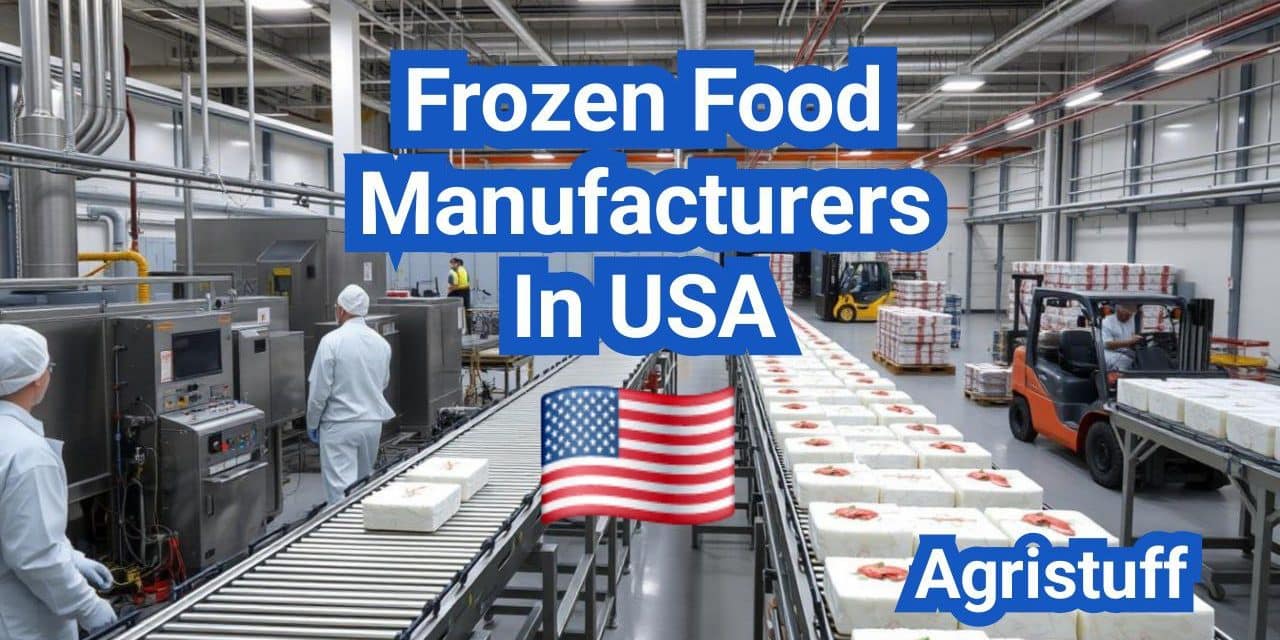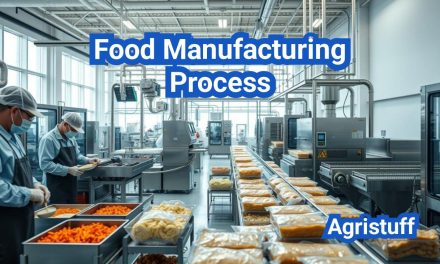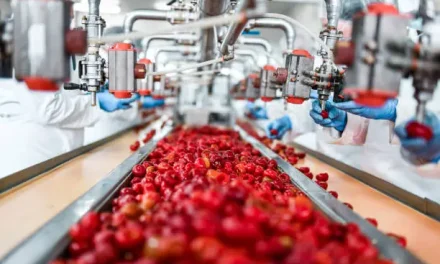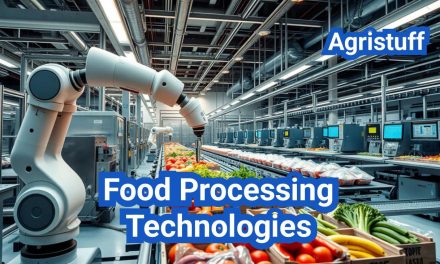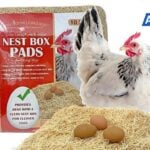The global frozen foods market is experiencing significant growth, with a projected CAGR of 5.1% from 2023 to 2033. As consumer demand for convenient and nutritious frozen products continues to rise, food manufacturers in the U.S. are adapting to changing preferences.
Two prominent freezing methods used by frozen food manufacturers are IQF (Individual Quick Freezing) and block freezing. While IQF preserves the texture and nutritional value of individual pieces, block freezing is often used for products like frozen vegetables and fruits.
To remain competitive in the U.S. market, manufacturers must prioritize retail readiness, ensuring their products meet the evolving needs of consumers and retailers alike.
Key Takeaways
- The global frozen foods market is projected to grow at a CAGR of 5.1% from 2023 to 2033.
- IQF and block freezing are two common freezing methods used by frozen food manufacturers.
- Retail readiness is crucial for manufacturers to remain competitive in the U.S. market.
- Consumer demand for convenient and nutritious frozen products is on the rise.
- Frozen food manufacturers must adapt to changing consumer preferences to stay ahead.
The State of the Frozen Food Industry in the United States
The U.S. frozen food industry is on the rise, fueled by changing consumer preferences and advancements in food technology. This growth is driven by the increasing demand for convenient, healthy, and sustainable food products.
Market Size and Growth Trends | Frozen Food Manufacturers
The frozen food market in the United States has seen significant growth in recent years. According to industry reports, the market size has expanded due to the rising demand for frozen meals and snacks. Growth trends indicate a continued increase in demand, driven by consumer preferences for convenience and quality.
The industry’s growth is also attributed to the expansion of distribution channels, including online platforms and retail stores. This has made frozen foods more accessible to a wider consumer base.
Consumer Demand Patterns | Frozen Food Manufacturers
Consumer demand for frozen foods is influenced by several factors, including health consciousness, convenience, and product variety. Consumers are seeking healthier options, driving the demand for frozen foods that are low in preservatives and rich in nutrients.
The demand for plant-based and vegan frozen food options is also on the rise, reflecting broader consumer trends towards sustainable and ethical eating.
Innovation Driving the Industry Forward
Innovation is a key driver of the frozen food industry’s growth. Manufacturers are investing in research and development to create new products that meet evolving consumer demands. Technological advancements in freezing and packaging are also improving product quality and shelf life.
The industry is witnessing a surge in innovative products, including frozen meals with global flavors and healthy snack options. This innovation is expected to continue driving the industry’s growth in the coming years.
Major Frozen Food Manufacturers in the USA

The U.S. frozen food manufacturing landscape is dominated by several key players who are driving innovation and meeting the growing demand for frozen products. These manufacturers range from large companies with extensive product portfolios to specialty and niche producers catering to specific market segments.
Top 10 U.S. Frozen Food Companies
The top 10 U.S. frozen food companies include well-known brands such as Bellisio Foods and Ajinomoto Frozen Foods. These companies have established themselves through their commitment to quality, innovative products, and robust distribution networks.
- Bellisio Foods: Known for their diverse product range and private label manufacturing capabilities.
- Ajinomoto Frozen Foods: Renowned for their high-quality frozen food products, particularly in the Asian cuisine segment.
- Other leading companies include those specializing in organic products, ethnic cuisine, and health-oriented frozen foods.
Specialty and Niche Manufacturers
Specialty and niche manufacturers play a crucial role in the frozen food industry by catering to specific consumer preferences and dietary needs. These manufacturers often focus on organic, gluten-free, or ethnic specialty products, providing consumers with a wide range of choices.
Private label manufacturing is another significant aspect, where companies produce frozen foods for retailers to brand and sell under their own labels. This model allows retailers to offer competitive pricing while maintaining quality standards.
Private Label Manufacturing Opportunities
Private label manufacturing presents a significant opportunity for frozen food manufacturers. By partnering with retailers, manufacturers can leverage their production capabilities and scale, while retailers benefit from offering high-quality products under their brand names.
The trend towards private label products is driven by consumer demand for affordable, high-quality food options. Manufacturers who can adapt to this trend by offering flexible production options and maintaining high-quality standards are likely to benefit from this growing market segment.
How to Select Freezing Technology for Your Products
With various freezing technologies available, such as IQF and block freezing, manufacturers must carefully evaluate their options to find the best fit for their products. The right freezing technology can significantly impact the quality, texture, and shelf life of frozen foods.
Evaluating Product Requirements | Frozen Food Manufacturers
When selecting a freezing technology, it’s essential to consider the specific requirements of your products. Different products have unique characteristics that demand specific freezing methods. For instance, IQF freezing is ideal for products that need to remain loose and separate, such as fruits, vegetables, and seafood.
- Product size and shape
- Moisture content
- Desired texture after thawing
- Sensitivity to freezer burn
Budget and Space Considerations | Frozen Food Manufacturers
Budget constraints and available space are critical factors in choosing a freezing technology. IQF freezing systems typically require a higher initial investment but offer long-term benefits in terms of product quality and reduced waste. On the other hand, block freezing is often more cost-effective upfront but may result in higher costs associated with product handling and storage.
Scalability and Future Growth Planning | Frozen Food Manufacturers
Scalability is another crucial consideration when selecting a freezing technology. Manufacturers should choose a system that can adapt to future growth and changing product lines. Modular freezing systems offer flexibility and can be expanded or modified as needed, making them an attractive option for businesses with evolving needs.
- Assess current production volumes and anticipated growth
- Evaluate the flexibility of different freezing technologies
- Consider the ease of integrating new equipment into existing production lines
By carefully evaluating product requirements, budget and space considerations, and scalability needs, frozen food manufacturers can make informed decisions about their freezing technology, ultimately enhancing product quality and operational efficiency.
Implementing IQF Freezing in Your Production Line
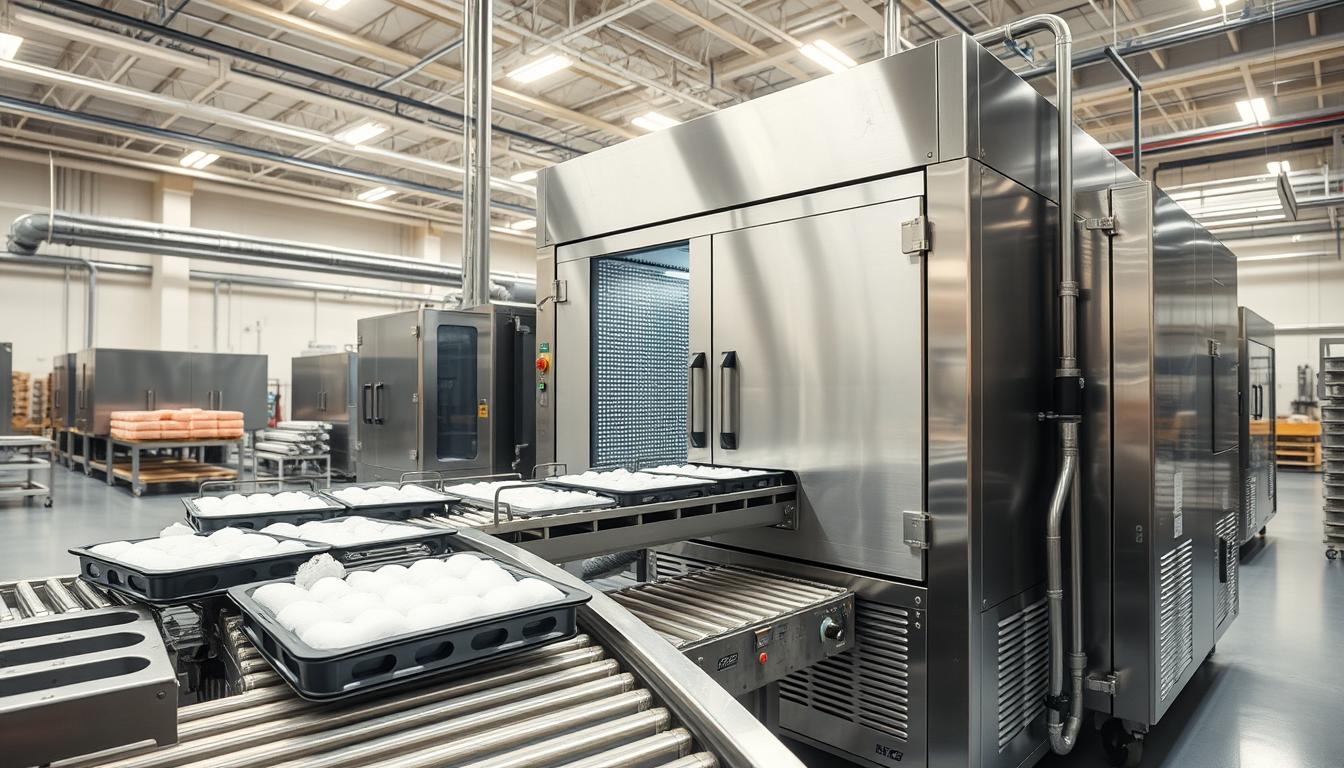
IQF freezing is a critical process for frozen food manufacturers looking to preserve product quality. This method involves freezing products individually, ensuring that they remain separate and retain their texture and flavor.
Equipment Setup and Requirements
To implement IQF freezing effectively, manufacturers need specialized equipment designed to handle the unique demands of this process. The primary equipment required includes IQF freezers, which come in various types such as fluidized bed, belt, and spiral freezers.
Key Considerations for IQF Freezer Selection:
- Product type and size
- Production capacity requirements
- Energy efficiency and operating costs
- Space constraints and facility layout
The choice of IQF freezer depends on the specific needs of the manufacturer, including the type of product being frozen and the desired production capacity.
Process Optimization for Different Food Types
Optimizing the IQF freezing process is crucial for achieving high-quality frozen products. Different food types require specific adjustments to the freezing process to ensure optimal results.
| Food Type | Freezing Temperature | Freezing Time |
|---|---|---|
| Fruits | -30°C to -40°C | 30-60 minutes |
| Vegetables | -30°C to -40°C | 20-40 minutes |
| Meat and Poultry | -40°C to -50°C | 60-120 minutes |
Quality Control Checkpoints
Maintaining quality control is essential throughout the IQF freezing process. Key checkpoints include monitoring the temperature and humidity levels during freezing, inspecting products for any signs of damage or deterioration, and ensuring that packaging is properly sealed.
Regular maintenance of IQF equipment is also crucial to prevent downtime and ensure consistent product quality.
By implementing these quality control measures, frozen food manufacturers can ensure that their products meet the highest standards of quality and safety.
Setting Up Block Freezing Operations
To establish an efficient block freezing operation, manufacturers must consider several key factors, including equipment and facility requirements. Block freezing is a cost-effective option for frozen food manufacturers, but it requires careful planning and execution to ensure product quality and safety.
Equipment and Facility Requirements
The first step in setting up block freezing operations is to select the appropriate equipment. This includes choosing the right type of freezer, such as a blast freezer or a plate freezer, based on the product characteristics and production volume. Facility requirements are equally important, as the freezer must be installed in a controlled environment that maintains consistent low temperatures.
The facility should also be designed to accommodate the freezer’s power requirements and to facilitate easy maintenance and cleaning. Additionally, manufacturers must ensure that their facilities comply with food safety regulations and standards.
Optimizing Freezing Cycles
Optimizing freezing cycles is crucial for achieving the desired product quality. This involves adjusting the freezing time and temperature based on the product’s specific requirements. Manufacturers should conduct thorough testing to determine the optimal freezing cycle for their products.
By optimizing freezing cycles, manufacturers can prevent issues such as freezer burn and ensure that their products retain their texture and flavor. This step is critical for maintaining customer satisfaction and loyalty.
Storage and Handling Procedures
After freezing, proper storage and handling procedures are essential for maintaining product quality. This includes storing frozen products at consistent low temperatures and ensuring that they are handled carefully to prevent damage.
Manufacturers should implement robust inventory management systems to track product storage and rotation, ensuring that products are sold or consumed before they deteriorate. By following these procedures, frozen food manufacturers can maintain the quality and safety of their products throughout the supply chain.
Choosing Between IQF vs. Block Freezing for Different Products
Understanding the differences between IQF and block freezing is essential for optimizing frozen food production. The choice between these two methods depends on various factors including product type, quality requirements, and production volume.
Product Quality Considerations
Product quality is a critical factor when deciding between IQF and block freezing. IQF (Individual Quick Freezing) is preferred for products that require individual freezing, such as fruits, vegetables, and seafood, as it preserves the texture and quality of each piece.
In contrast, block freezing is often used for products that can be frozen together in a block, such as certain types of fish or prepared meals. While block freezing can be more cost-effective, it may compromise on product quality due to the formation of ice crystals between products.
- IQF maintains product integrity and prevents clumping.
- Block freezing can lead to product sticking together.
Cost Analysis and ROI Calculations
Cost is another crucial consideration. IQF systems typically require a higher initial investment due to the complexity of the equipment. However, they offer long-term savings through reduced product loss and improved efficiency.
Block freezing, while less expensive upfront, may incur higher operational costs over time due to energy consumption and potential product damage.
- Evaluate the initial investment for IQF vs. block freezing equipment.
- Consider the long-term operational costs and potential savings.
- Calculate the ROI based on product yield and quality.
Production Flexibility and Market Demands
Production flexibility is vital in responding to market demands. IQF systems offer greater flexibility as they can handle a variety of products and production volumes.
Block freezing, while less flexible, can be optimized for high-volume production of specific products, making it suitable for manufacturers with a consistent product line.
Key considerations include:
- Product mix and variability.
- Production volume and scalability.
- Market trends and consumer preferences.
Achieving FSMA Compliance for Frozen Food Manufacturers

The Food Safety Modernization Act (FSMA) has transformed the landscape for frozen food manufacturers, requiring a proactive approach to food safety. As a result, achieving FSMA compliance is crucial for ensuring product safety and avoiding costly penalties.
Implementing Preventive Controls
Preventive controls are a critical component of FSMA compliance. Frozen food manufacturers must identify and implement controls to mitigate potential hazards in their production processes. This includes developing a food safety plan that outlines the preventive controls and procedures for monitoring and verifying their effectiveness.
Effective preventive controls may include measures such as temperature controls during processing and storage, allergen controls, and sanitation procedures. By implementing these controls, manufacturers can significantly reduce the risk of contamination and ensure compliance with FSMA regulations.
Meeting Sanitary Transportation Requirements
Sanitary transportation practices are essential for maintaining the safety and integrity of frozen foods during transportation. FSMA regulations require that frozen food manufacturers ensure their transportation practices meet specific sanitary standards. This includes maintaining appropriate temperature controls during transportation and ensuring that vehicles and equipment are properly cleaned and sanitized.
To comply with sanitary transportation requirements, manufacturers should develop and implement transportation protocols that outline procedures for loading, transporting, and unloading frozen foods. Regular training for transportation personnel is also crucial to ensure that they understand and follow these protocols.
Establishing Traceability Systems (FSMA 204)
Traceability is a key aspect of FSMA compliance, enabling manufacturers to quickly identify and recall products in the event of a food safety issue. FSMA 204 requires frozen food manufacturers to establish and maintain traceability systems that can track products throughout the supply chain.
To meet this requirement, manufacturers should implement a robust traceability system that includes tracking key data elements such as product identifiers, lot numbers, and shipping information. This will enable them to quickly respond to food safety issues and minimize the risk of product recalls.
Establishing and Maintaining the Frozen Cold Chain

Establishing a robust frozen cold chain is essential for frozen food manufacturers to maintain product integrity throughout the supply chain. The frozen cold chain refers to the series of actions and procedures designed to maintain a consistent refrigerated temperature during the storage, transportation, and display of frozen foods.
Critical Temperature Control Points
Setting critical temperature control points is vital to prevent temperature fluctuations that can compromise product quality. Frozen foods should be stored at 0°F (-18°C) or below to maintain their quality and safety. Temperature control is crucial during storage, transportation, and display.
To achieve this, manufacturers should:
- Use calibrated temperature monitoring devices
- Implement automated temperature recording systems
- Train personnel on temperature control procedures
Implementing Monitoring Systems
Effective monitoring systems are necessary to ensure that the frozen cold chain is maintained. This includes:
- Real-time temperature monitoring
- Alarm systems for temperature deviations
- Regular maintenance of refrigeration equipment
Data loggers can be used to track temperature throughout the supply chain, providing a record of temperature exposure during transportation and storage.
Managing Transportation and Storage Challenges
Managing transportation and storage challenges is critical to maintaining the frozen cold chain. This involves:
| Challenge | Solution |
|---|---|
| Temperature fluctuations during transportation | Use refrigerated trucks with temperature monitoring systems |
| Inadequate storage facilities | Ensure storage facilities are equipped with reliable refrigeration systems |
| Delays in transportation | Plan routes and schedules to minimize delays |
By addressing these challenges, frozen food manufacturers can maintain the integrity of their products throughout the supply chain.
The food traceability rule (FSMA 204) also plays a crucial role in maintaining the frozen cold chain by ensuring that products can be traced back to their source in case of quality or safety issues.
Complying with Frozen Food Labeling Requirements

Accurate labeling is a critical aspect of frozen food production, impacting both consumer choice and regulatory compliance. Frozen food manufacturers must navigate a complex landscape of labeling requirements to ensure their products meet regulatory standards.
Creating Compliant Nutrition Facts Panels
Nutrition facts panels are a crucial element of frozen food labeling, providing consumers with essential information about the product’s nutritional content. To create compliant nutrition facts panels, manufacturers must adhere to the FDA’s guidelines, including the display of serving size, calories, and key nutrients such as fat, sodium, and total carbohydrates.
Key components of a compliant nutrition facts panel include:
- Serving size and servings per container
- Calories and calories from fat
- Total fat, saturated fat, and trans fat
- Cholesterol and sodium
- Total carbohydrates, dietary fiber, and total sugars
- Protein content
- Vitamins and minerals (if applicable)
Implementing Allergen Labeling for the Big 9
The Big 9 allergens, as defined by the FDA, include milk, eggs, fish, shellfish, tree nuts, peanuts, wheat, soybeans, and sesame. Frozen food manufacturers must clearly label products that contain any of these allergens to protect consumer health.
| Allergen | Labeling Requirement |
|---|---|
| Milk | Contains milk or milk derivatives |
| Eggs | Contains eggs or egg products |
| Fish and Shellfish | Contains fish or shellfish, specifying the type |
| Tree Nuts and Peanuts | Contains tree nuts or peanuts, specifying the type |
| Wheat, Soybeans, and Sesame | Contains wheat, soybeans, or sesame |
Developing Compliant Marketing Claims
Marketing claims on frozen food labels can significantly influence consumer purchasing decisions. However, these claims must comply with FDA regulations to avoid being considered misleading. Manufacturers should ensure that any health or nutrient claims are substantiated by scientific evidence and comply with FDA guidelines.
Examples of compliant marketing claims include:
- “Low Sodium”: Meets FDA criteria for low sodium content
- “High in Fiber”: Contains a significant amount of dietary fiber
- “Gluten-Free”: Complies with FDA standards for gluten-free labeling
By understanding and complying with frozen food labeling requirements, manufacturers can ensure their products are both competitive in the market and compliant with regulatory standards, ultimately protecting consumer health and safety.
Mastering Glazing Techniques for Frozen Foods

Mastering glazing techniques is crucial for frozen food manufacturers to ensure product quality and retail readiness. Glazing is a critical process that not only enhances the appearance of frozen foods but also protects them from freezer burn and dehydration.
Selecting Appropriate Glazing Methods
The choice of glazing method depends on the type of product, its texture, and the desired outcome. Common glazing methods include drum glazing, drum and brush glazing, and electrostatic glazing. Each method has its advantages and is suited for different types of frozen foods.
Drum Glazing: This method involves tumbling the frozen product in a drum with a glaze solution. It’s efficient for large quantities and ensures uniform coating.
Electrostatic Glazing: This technique uses an electrostatic charge to attract the glaze to the product, resulting in a precise and even coating. It’s particularly useful for products with complex shapes.
Controlling Glaze Percentage
Controlling the glaze percentage is vital to ensure that the product meets the required standards without excessive glaze application, which can add unnecessary cost and affect product quality.
| Glazing Method | Typical Glaze Percentage | Product Suitability |
|---|---|---|
| Drum Glazing | 10-15% | IQF Fruits, Vegetables |
| Electrostatic Glazing | 5-10% | Complex Shaped Products |
| Drum and Brush Glazing | 8-12% | Seafood, Meat Products |
Monitoring Quality and Consistency
To maintain high-quality products, it’s essential to monitor the glazing process continuously. This includes checking the glaze percentage, product appearance, and ensuring that the glazing equipment is clean and functioning correctly.
Regular audits and quality control checks help in identifying any deviations from the set standards, allowing for prompt corrective actions.
Implementing GS1 Barcode and Case Labeling Standards
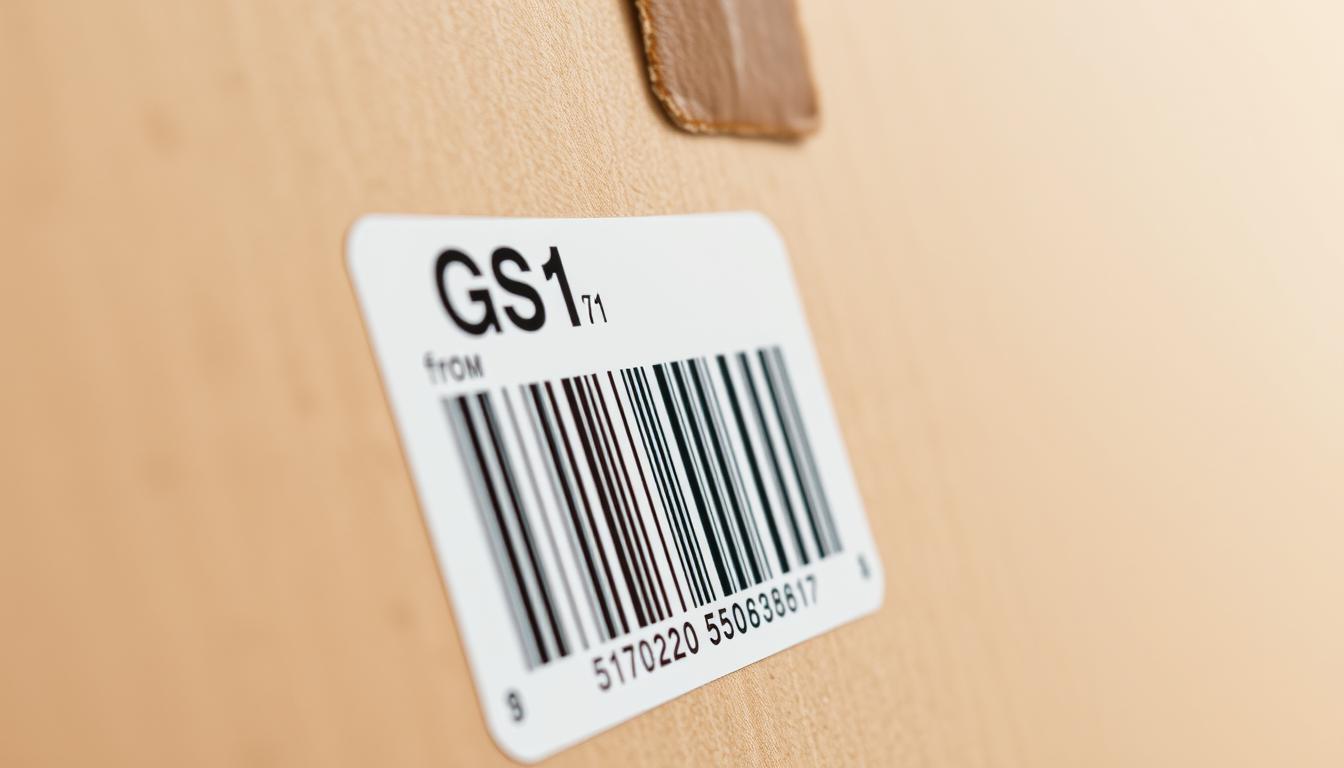
To ensure seamless supply chain operations, frozen food manufacturers must adopt GS1 barcode and case labeling standards. These standards are crucial for enhancing the efficiency of frozen food distribution and ensuring retail readiness.
Setting Up GS1 System Compliance
Setting up GS1 system compliance involves several key steps. First, manufacturers must obtain a GS1 Company Prefix, which is essential for creating unique identifiers for their products. According to GS1 US, “the GS1 Company Prefix is the foundation for creating GS1 identification keys.”
Key steps for GS1 system compliance include:
- Obtaining a GS1 Company Prefix
- Assigning unique GS1 identification keys to products
- Implementing GS1 barcodes on product packaging
Creating Retail-Ready Case Labels
Creating retail-ready case labels is critical for ensuring that products can be efficiently processed and tracked throughout the supply chain. GS1 standards provide a framework for creating these labels, which include essential information such as product identifiers, batch numbers, and expiration dates.
A well-designed case label can significantly improve supply chain visibility. For instance, using GS1-128 barcodes on case labels can help automate the tracking process, reducing manual errors and increasing efficiency.
Establishing Verification Processes
Establishing verification processes is vital to ensure that GS1 barcodes and case labels are accurate and compliant with industry standards. This involves regular checks and validation of the barcodes and labels to prevent errors.
“Verification processes are essential for maintaining the integrity of GS1 barcodes and case labels, ensuring that they can be accurately read and processed throughout the supply chain.”
By implementing these verification processes, frozen food manufacturers can minimize the risk of supply chain disruptions and ensure that their products are retail-ready.
Retail Readiness Checklist for Frozen Food Manufacturers

Ensuring retail readiness is crucial for frozen food manufacturers to succeed in the competitive U.S. market. Retailers have specific requirements for packaging, labeling, and distribution, which manufacturers must meet to ensure their products are store-ready.
Meeting Packaging and Presentation Standards
Frozen food manufacturers must adhere to strict packaging and presentation standards to ensure their products are retail-ready. This includes using appropriate packaging materials that protect the product during transportation and storage.
According to industry experts, “The packaging of frozen foods plays a critical role in maintaining product quality and safety.” Manufacturers should also consider the visual appeal of their packaging, as it can significantly impact consumer purchasing decisions.
- Use durable and moisture-resistant packaging materials
- Ensure clear labeling and compliance with regulations
- Optimize packaging design for retail display
Addressing Retailer-Specific Requirements
Different retailers have unique requirements for frozen food products, including specific labeling, packaging, and delivery requirements. Manufacturers must be aware of these requirements to ensure compliance.
For instance, some retailers may require GS1 barcode compliance for all products, while others may have specific requirements for case labeling and pallet configuration.
- Research retailer-specific requirements
- Adjust packaging and labeling accordingly
- Verify compliance with retailer requirements
Preparing for Distribution Challenges
Frozen food manufacturers must be prepared to handle distribution challenges, including maintaining consistent refrigeration temperatures during transportation and storage.
As noted by industry leaders, “Maintaining the frozen cold chain is critical to ensuring product safety and quality.” Manufacturers should invest in robust cold chain management systems to mitigate the risk of temperature fluctuations.
| Distribution Challenge | Solution |
|---|---|
| Temperature fluctuations | Robust cold chain management systems |
| Delays in transportation | Real-time tracking and monitoring |
By following this retail readiness checklist, frozen food manufacturers can ensure their products meet retailer requirements and are well-positioned for success in the U.S. market.
Developing Ethnic and Specialty Frozen Food Products

The frozen food industry is witnessing a significant shift towards ethnic and specialty products, catering to the adventurous tastes of modern consumers. As the demand for diverse and authentic ethnic flavors continues to grow, manufacturers are presented with opportunities to innovate and expand their product lines.
Researching Market Opportunities
To successfully develop ethnic and specialty frozen foods, manufacturers must first research market opportunities. This involves understanding consumer preferences, identifying trends, and analyzing competitors. Key areas to focus on include:
- Identifying the largest categories of ethnic frozen foods in demand
- Analyzing consumer behavior and purchasing patterns
- Exploring emerging trends in international cuisine
By conducting thorough market research, manufacturers can identify niche areas with potential for growth and develop products that meet the evolving needs of consumers.
Adapting Production Processes
Once market opportunities are identified, manufacturers must adapt their production processes to accommodate the development of ethnic and specialty frozen foods. This may involve:
- Investing in new equipment or technology to handle diverse ingredients and production requirements
- Training production staff on new recipes and preparation methods
- Implementing quality control measures to ensure consistency and authenticity
Adapting production processes effectively is crucial for delivering high-quality ethnic and specialty frozen foods that meet consumer expectations.
Creating Authentic Flavor Profiles
Creating authentic flavor profiles is essential for the success of ethnic and specialty frozen foods. This involves:
- Sourcing high-quality, authentic ingredients
- Developing recipes that accurately represent the flavors of the target cuisine
- Testing products with consumer panels to ensure flavor profiles meet expectations
By focusing on authenticity and quality, manufacturers can build trust with consumers and establish a strong reputation in the market for ethnic and specialty frozen foods.
Here is a table summarizing the key considerations for developing ethnic and specialty frozen food products:
| Aspect | Key Considerations |
|---|---|
| Market Research | Consumer preferences, trends, competitor analysis |
| Production Adaptation | New equipment, staff training, quality control |
| Flavor Profiles | Authentic ingredients, accurate recipes, consumer testing |
By understanding market opportunities, adapting production processes, and creating authentic flavor profiles, manufacturers can successfully develop ethnic and specialty frozen food products that resonate with consumers.
Positioning Your Frozen Food Manufacturing Business for Success
The frozen food industry is highly competitive, and manufacturers must be adaptable and innovative to succeed. To position your frozen food manufacturing business for success, it’s crucial to stay ahead of industry trends, invest in quality and safety, and adapt to changing consumer preferences.
Frozen food manufacturers can achieve business success by implementing the right freezing technology, such as IQF or block freezing, and ensuring retail readiness. By understanding consumer demand patterns and innovating products, such as ethnic and specialty frozen foods, businesses can stay competitive in the market.
Ultimately, success in the frozen food industry requires a combination of quality products, efficient operations, and compliance with regulations. By focusing on these key areas, frozen food manufacturers can drive business success and thrive in a competitive market.
FAQ
What is the difference between IQF and block freezing?
IQF (Individual Quick Freezing) is a method that freezes individual pieces of food quickly, preserving their texture and quality. Block freezing, on the other hand, involves freezing larger blocks of food together, which can affect texture and quality.
What are the benefits of IQF freezing?
IQF freezing offers several benefits, including preserving the texture and quality of food, reducing ice crystal formation, and allowing for easier packaging and portion control.
How do I choose between IQF and block freezing for my products?
The choice between IQF and block freezing depends on the type of product, its intended use, and the desired quality characteristics. Consider factors such as product texture, packaging requirements, and production volume.
What are the key considerations for achieving FSMA compliance?
To achieve FSMA compliance, frozen food manufacturers must implement preventive controls, meet sanitary transportation requirements, and establish traceability systems. This includes identifying potential hazards, implementing controls, and maintaining records.
How can I ensure the integrity of my frozen cold chain?
To maintain the frozen cold chain, set critical temperature control points, implement monitoring systems, and manage transportation and storage challenges. This includes using temperature-controlled storage and transportation equipment and training personnel.
What are the requirements for compliant frozen food labeling?
Compliant frozen food labeling requires creating accurate nutrition facts panels, implementing allergen labeling for the Big9, and developing compliant marketing claims. Ensure that labels meet FDA regulations and are accurate, clear, and concise.
How can I master glazing techniques for frozen foods?
To master glazing techniques, select appropriate glazing methods, control glaze percentage, and monitor quality and consistency. This includes using the right glazing materials, adjusting glaze application rates, and inspecting products regularly.
What are the benefits of implementing GS1 barcode and case labeling standards?
Implementing GS1 barcode and case labeling standards improves supply chain efficiency, reduces errors, and enhances product tracking. This includes using standardized barcodes and labels that meet retailer requirements.
How can I ensure retail readiness for my frozen food products?
To ensure retail readiness, meet packaging and presentation standards, address retailer-specific requirements, and prepare for distribution challenges. This includes using attractive and functional packaging, complying with retailer requirements, and coordinating with distributors.
What opportunities exist for developing ethnic and specialty frozen food products?
Developing ethnic and specialty frozen food products offers opportunities to tap into growing consumer demand for diverse and authentic flavors. Research market opportunities, adapt production processes, and create authentic flavor profiles to succeed in this niche.
Conclusion of: Frozen Food Manufacturers In USA
Overview: Why Frozen Food Still Wins
Frozen food manufacturers keep America’s mealtime moving—delivering produce, seafood, meat, dairy, and complete meals with year-round consistency, predictable costs, and rigorous food safety. For frozen food manufacturers, the playbook blends engineering (freezing method and packaging), compliance (FSMA, allergen labeling), and execution (cold-chain performance and traceability) to land retail-ready cases that move without deductions or delays. FDA FSMA Preventive Controls overview.
U.S. Market Context for Frozen Categories
Frozen food manufacturers serve consumers who value convenience, price stability, and reduced household waste—demand drivers that remained resilient across inflationary cycles. When frozen food manufacturers plan capacity or new SKUs, tracking retail price outlook and category dynamics helps align formats and pack sizes to shopper behavior. USDA ERS Food Price Outlook.
IQF vs. Block Freezing—What’s the Difference?
IQF (individually quick freezing) freezes pieces separately so they stay free-flowing (peas, berries, shrimp, diced meats), while block freezing forms solid blocks ideal for dense storage (fillets, large cuts, batch meats). Frozen food manufacturers choose IQF to maximize portionability and culinary quality, and choose block freezing to optimize throughput and cube efficiency. FAO: Freezing methods and product considerations.
Freezing Rate and Product Quality
Small ice crystals protect texture and reduce drip loss; large crystals damage cells and degrade eating quality. That’s why frozen food manufacturers turn to air-blast tunnels, fluidized-bed IQF lines, or cryogenic tunnels to accelerate heat removal for premium bite and color retention. IIR: Cryogenic nitrogen in food processing.
When IQF Is the Right Choice
IQF shines when retailers and foodservice buyers need portion control, fast cook times, mix-in compatibility, or high visual appeal. Frozen food manufacturers also favor IQF for value-add coatings and seasonings because keeping pieces separate supports even application and consistent yields. Oregon State University: Planning for Seafood Freezing.
When Block Freezing Lowers the Total Cost
Block freezing is efficient for large pieces and commodities—tight stacking, dense pallets, and fewer consumer-unit materials. Frozen food manufacturers often use plate freezers for fish fillets and meats before later fabrication, accepting that portion flexibility will be lower than with IQF. FAO: Freezer types (air-blast, plate, tunnel).
Glazing: Surface Protection for IQF
A controlled water “glaze” after IQF helps prevent dehydration and oxidation. Frozen food manufacturers calibrate glaze pickup to protect surfaces without inflating declared net weight, preserving label accuracy and sensory quality over shelf life. FAO: Glazing and storage practices.
FSMA Preventive Controls & CGMPs
Under FSMA, facilities must conduct hazard analyses and implement preventive controls, supported by Current Good Manufacturing Practice (CGMP). Frozen food manufacturers rely on documented sanitation, allergen programs, environmental monitoring, and process verification to meet audits and reduce risk. eCFR: 21 CFR Part 117.
Labeling for Retail Readiness: Allergens & Ingredients
Retail labels must accurately declare ingredients and the “Big 9” allergens (including sesame under the FASTER Act). Frozen food manufacturers that standardize label reviews and change controls cut time-to-shelf and avoid costly rework. FDA Guidance: Food Allergen Labeling (Edition 5).
Nutrition Facts, Net Contents, and Format
U.S. retail packages need compliant Nutrition Facts, serving sizes, and net quantity statements on the principal display panel. Frozen food manufacturers should lock formats before line trials to avoid relabeling and shipping holds. eCFR: 21 CFR 101.9 Nutrition labeling.
Barcodes, GTINs, and Case Coding
Retailers expect GS1 identifiers on consumer units (UPC/GTIN) and standardized case labels (often GS1-128 with lot/date). Frozen food manufacturers that follow barcode placement and print quality guidance reduce receiving errors and chargebacks. GS1 US: GS1-128 barcode guidance.
Sanitary Transportation: Legal Baseline for the Cold Chain
The Sanitary Transportation rule defines responsibilities for shippers, loaders, carriers, and receivers. Frozen food manufacturers specify equipment, verify pre-cooling, and document temperatures so loads stay compliant from plant dock to DC. eCFR: 21 CFR Part 1 Subpart O.
Cold-Chain Targets and Best Practices
A simple benchmark—keep frozen products at 0°F (-18°C) or below—protects quality and safety. Frozen food manufacturers align storage and distribution SOPs with this target and validate monitoring systems and thresholds. FoodSafety.gov: Cold storage charts.
Industry Resources for Temperature Management
Beyond regulatory baselines, industry groups document unified approaches to monitoring, recording, and reconciling temperatures across custody handoffs. Frozen food manufacturers leverage these resources to standardize specs with carriers and 3PLs. GCCA: Cold chain resources.
Date Labeling That Retailers Prefer
U.S. agencies encourage simple, quality-focused phrasing like “Best if Used By” to reduce confusion and waste. Frozen food manufacturers can usually adopt this language without changing safety controls or shelf-life validation programs. USDA FSIS: Food Product Dating.
Traceability: When FSMA 204 Applies
FSMA’s Food Traceability Rule adds recordkeeping requirements for items on the Food Traceability List (FTL), including many fresh and frozen seafood SKUs. Frozen food manufacturers should map SKUs to the FTL and prepare Key Data Elements and Critical Tracking Events well before customer deadlines. FDA: FSMA 204 & Food Traceability List.
Packaging That Survives Sub-Zero Reality
Barrier properties, seal integrity, and abuse resistance are central to maintaining product quality. Frozen food manufacturers validate films and closures for low-temperature brittleness and specify scannable symbols to keep receiving fast and accurate. GS1 US: Place barcodes on products.
Food-Code Temperatures and Cooling Logic
Although aimed at retail and foodservice, the FDA Food Code’s 41°F (5°C) cold-holding benchmark and cooling profiles are widely referenced by QA and customer teams. Frozen food manufacturers often show how their HACCP or Preventive Controls avoid time-temperature danger zones prior to freezing. FDA: Summary of 2022 Food Code changes.
Marketing Claims That Actually Move Product
Convenience, nutrition lock-in, and lower household waste remain durable value props. Frozen food manufacturers that right-size pack counts and claim language to shopper insights tend to see better retail velocity and repeat. AFFI & FMI: The Power of Frozen in Retail.
Retail Readiness Checklist (At a Glance)
Before shipping, frozen food manufacturers should confirm: validated process controls, compliant labels (Nutrition Facts, ingredients, allergens), GS1 identifiers and case codes, signed spec sheets with retailer chargeback terms, and documented cold-chain responsibilities across all parties. FDA: Food Labeling Guide.
Final thought
In practice, frozen food manufacturers balance merchandising intent and line economics: IQF maximizes portionability and perceived quality, while block freezing maximizes density and throughput. Layering strong FSMA compliance, disciplined GS1 data, and verifiable 0°F cold-chain performance gives frozen food manufacturers the retail readiness that keeps deductions low and repeat sales high. eCFR: 21 CFR Part 117 (CGMP & Preventive Controls).
Sources & References
- FDA: FSMA Preventive Controls for Human Food
- eCFR: 21 CFR Part 117
- eCFR: 21 CFR Part 1 Subpart O (Sanitary Transportation)
- FDA Guidance: Food Allergen Labeling (Edition 5)
- eCFR: 21 CFR 101.9 (Nutrition Labeling)
- USDA ERS: Food Price Outlook
- FDA: Summary of 2022 Food Code Changes
- FoodSafety.gov: Cold Food Storage Charts
- FAO: Freezing & Refrigerated Storage—Principles
- FAO: Freezers and Freezing Times
- FAO: Glazing and Storage Practices
- IIR: Cryogenic Nitrogen in Food Processing
- Oregon State University: Planning for Seafood Freezing
- GS1 US: Place Barcodes on Products
- FDA: Food Labeling Guide
- FDA: FSMA 204 Traceability Rule & FTL
- AFFI/FMI: The Power of Frozen in Retail
- GCCA: Cold Chain Resources

